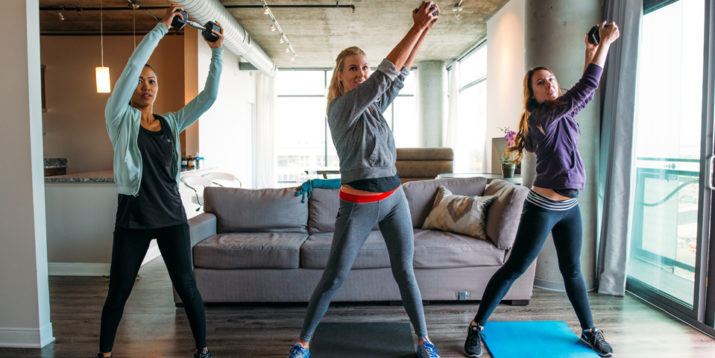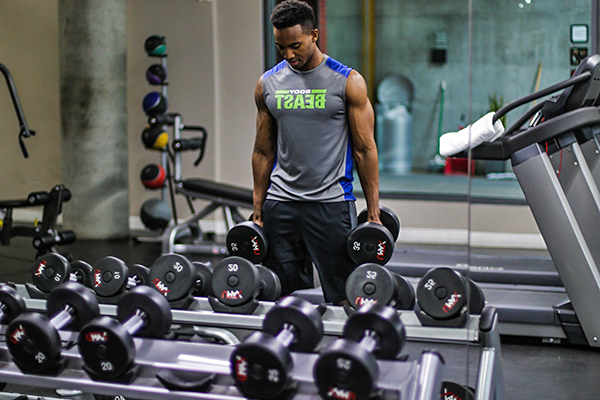Why Your Daily Workout Routine Isn’t Working

Improving your health and fitness takes time and hard work.
You shouldn’t expect to see changes after one or two workouts, but if your daily workout routine isn’t producing noticeable results after a month or so, there might be a good reason why.
How do you know if your exercise routine isn’t working? According to Beachbody fitness expert Cody Braun, there are a few telltale signs: “Lack of progress toward your goal, lack of performance improvement, and new or nagging injuries,” he says.
William P. Kelley, C.S.C.S, ACT, adds that your daily workout routine could be lacking if you no longer get sore from your workouts, meaning “you [probably] aren’t overloading the muscle enough to elicit change,” he explains.
If you’re unsure about the efficacy of your daily workout routine, assess your situation: Do you still look the same after six months of exercise? Are you lifting the same amount of weight you did when you started? Do you have new or worsening injuries? Are you losing muscle?
These all may be indicators that you need to change your approach to exercise.
Why Your Daily Workout Routine Isn’t Producing Results — And What To Do About It
Take a look through these 11 potential problems in your daily exercise routine. If one (or more) of them sounds like it applies to you, try the suggested solutions to get back on-track.
1. You don’t have a clear goal
Exercising without an intention makes for aimless, inconsistent workouts. If you don’t have a clear goal, chances are good you don’t have a barometer for measuring your progress, which means you won’t know what type of results to look for.
Solution:
“Before you start your journey, you should know what it is you want to accomplish,” Braun says.
Do you want to lose weight? Gain muscle? Run three miles without collapsing? Once you get clear on why you’re exercising, you can create a SMART goal (one that’s Specific, Measurable, Attainable, Realistic, and Time-Sensitive).
From there, Braun suggests setting benchmarks, which gives you a way to check your progress while also helping you stay motivated and focused. Try using a journal or tracking app to monitor your progress more effectively.
2. You’re not challenging yourself enough
You don’t need to be on the brink of exhaustion after every sweat session, but you won’t see results with your daily exercise routine if you’re constantly breezing through your workouts.
“You want to keep pushing your limits to force the body into adaptation,” Braun says. As your body gradually adapts to a specific workout, you become stronger, more efficient, and more conditioned, he explains. “Once a workout that used to seem difficult starts becoming easier, it’s time to increase your intensity again,” he says.
Solution:
To ensure you’re pushing yourself hard enough, Kelley suggests creating mini-goals, like setting a weekly cardio PR or increasing the amount of weight you lift by 5 percent each week.
Another strategy is to wear a heart-rate monitor, says Amanda Dale, ACE-certified trainer and sports nutritionist. “If you think you’re working hard [during a high-intensity cardio session], but you’re not seeing heart rates above 80–85 percent for at least 10 minutes of the effort, you may not be doing as much as you think,” she explains.
You can also calculate your RPE (Rate of Perceived Exertion) by observing how you feel — if you’re breathing heavy or struggling to complete your final reps, for example.

3. You do the exact same thing every day
In a similar vein as the point above, doing the same exact daily workout routine (down to the number of reps) day after day and week after week is a surefire way to stall your progress.
“Once you become efficient at something, you need to add a new stimulus to keep your body adapting and improving,” explains Braun. “The stimulus could be weight, speed, apparatus, or rest,” he says.
Solution:
Try adjusting the amount of weight you lift, changing your number of reps, reducing your rest periods during HIIT workouts, or adding sprints to your cardio session. You can even alternate the days you work certain muscle groups, suggests Kelley.
4. You jump from one workout type to the next
And now for the opposite problem: too much change. Bouncing from Pilates to circuit training to running all within a week — and then something entirely new the following week — may seem like the smartest way to shock your body into shape (and avoid boredom), but this strategy can actually backfire.
“If you change your workouts too often you won’t give your body the chance to improve upon those exercises and movements, so very little adaptation happens,” Braun says.
Solution:
Exercise ADD is real, but if you want to see significant progress, stick with a consistent exercise routine (for example, strength training three days a week and biking 2 days) for a minimum of four weeks.
“This will help you stay committed to the workout you are doing, [while] setting an optimum time to jump to a new workout routine,” Kelley says.

5. You’re not sleeping enough
Getting adequate sleep is critical to improving your fitness. “Without [sufficient] sleep, your muscles never fully repair or grow stronger, meaning you lack energy for your next workout and you can’t perform your best,” Dale explains.
If you sleep fewer than seven hours a night and feel fatigued or foggy on a regular basis, you probably need to make some adjustments.
Solution:
Set a regular bedtime and aim for a minimum of seven hours a night to allow your body and mind an opportunity to rejuvenate, Dale says.
She also recommends developing a nightly ritual if you have trouble winding down: take a hot bath, drink a cup of herbal tea, meditate, or read a book.
Natural sleep remedies can go a long way toward helping you get a solid snooze.
6. You’re not giving yourself time to recover
Insufficient recovery time between workouts can impede your progress and make you more susceptible to injuries. “You can only push your body so hard before it will shut down,” Braun says.
If you find yourself overly sore, exhausted, or consistently in pain, you’re probably not giving your body enough time to recuperate.
Solution:
Give yourself a day or two of rest for each muscle group worked, Braun suggests. For example, if you do leg exercises one day, don’t stress the same muscles by doing a tempo run the next day.
Take the day off or target your upper-body muscles instead with something like a strength workout or swim session. This type of active recovery should be an important part of your workout routine, Kelley says.
7. You’re not practicing proper form
There’s a difference between doing a move that “hurts so good” because it’s challenging your muscles and doing a move that just plain hurts your body. If you notice that an exercise is causing that second result, you should check your form.
“Moving incorrectly can lead to pains and discomfort,” Braun says. “When you don’t exercise with proper form, your muscles won’t work optimally, which will inhibit some of your progress.”
Bad form is also a surefire way to set yourself up for injury down the road.
Solution:
Don’t attempt an exercise unless you understand the mechanics of the movement. If you’re following a workout program on Beachbody On Demand, pay close attention to the trainers when they demonstrate the exercise with proper form.
From there, use a mirror to check your form throughout the workout and adjust your position as needed.
8. You’re not eating enough protein
“Your muscles need protein to recover and rebuild, so if you aren’t getting enough you could be limiting your results,” Braun says.
One good indicator that you may not be consuming enough protein is a loss of muscle mass, Dale says.
Solution:
To maximize muscle growth and repair, aim to consume about 20 grams of protein within about 30 minutes after your workout, Dale advises. Eggs, chicken, and Greek yogurt are all great sources, she says, as are high-quality supplements, like Beachbody Performance Recover.
Both the chocolate and orange flavors have 20 grams of protein in each serving to help facilitate muscle recovery, plus pomegranate extract to help reduce muscle soreness.
9. You’re not hydrating properly
Skimping on water, either before, during, or after your workout, can derail your daily exercise routine. “Without water, your body feels depleted of energy,” Dale says, which means you may not be able to give as much effort to your workout.
Plus, without sufficient water intake, Dale adds that you could also experience irregular bowel movements, increased feelings of hunger, and bloating. If you’re getting plenty of sleep and still feel fatigued or mentally fuzzy, you may need to up your H20 intake.
Solution:
As a general rule, Beachbody recommends using your weight to figure out how much water to drink: divide your body weight by two and drink that amount in ounces. “Add another liter (32 ounces) if you’re working out hard or outdoors that day,” Dale suggests.
If you can’t keep track of how many times you refill your reusable water bottle, buy a gallon jug (128 ounces) instead, suggests Kelley.
Draw lines on the jug labeled with times (8am, 12pm, 3pm, etc.) to keep you on-track throughout the day.

10. You’re not eating the right amount of calories
Both eating too much or not enough can impact how your body responds to exercise. Generally, eating too few calories can cause you to lose muscle and fat, Dale says.
Exceeding your daily calorie count, on the other hand, can cause you to gain fat, Braun says.
Solution:
Refer back to your fitness goals. “[To lose weight] you need to be in some form of a caloric deficit in order for your body to pull energy from stored sources,” Braun explains.
But if you’re trying to build muscle and mass, you need to eat more calories than usual, he says. Determining the right amount of calories for your specific body type and goals can be tricky, so here’s a good place to start.
Once you have a number, be diligent about sticking to it. “Tracking calories on an app is a good way to maintain accountability with nutrition, and can also help curb overeating,” says Kelley.
11. You’re bored with your workouts
The way you view your workout program impacts how you approach and execute the workout. So, if the thought of your workout makes you want to bang your head against the wall, chances are good you’ll only give it half the effort — or skip it completely.
And while it’s normal to occasionally feel like you’re not in the mood to exercise, you shouldn’t despise or dread your workouts every day.
Solution:
Choose a daily exercise routine that aligns with both your interests and goals. Ideally, it should get you excited to move and challenge yourself.
If you love to get your heart rate up but hate traditional cardio like running, try a dance workout.
Or, if you’re not a fan of the gym, opt for an in-home workout à la Beachbody On Demand. “Not every workout will be fun,” Braun says, “but you have to trust the process and remind yourself why you are exercising.”
And that’s why it’s so important to start off with a solid goal. (see tip #1)
Workout Wisdom
If you’re not seeing results with your daily workout routine, it may be time to change things up. Beyond choosing a smart exercise regimen — one that challenges you to continually push yourself — the right nutrition, sleep, hydration, and recovery are crucial to improving your fitness.
Once you identify why your routine isn’t working, you can start taking steps toward improving it.

